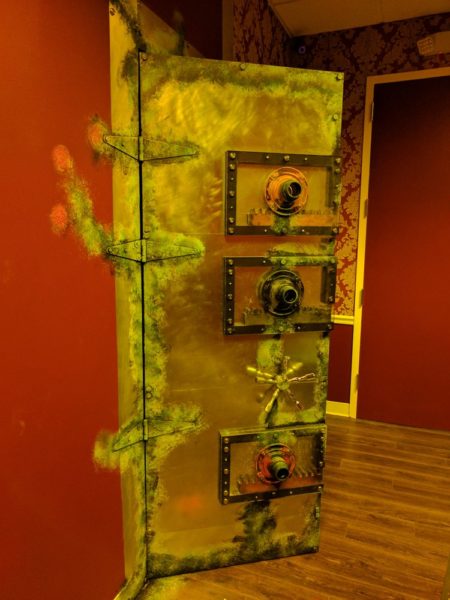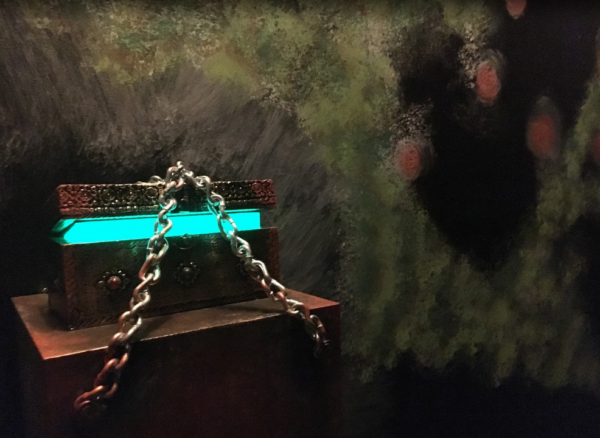RATING: 4 Keys RESULT: Win REMAINING: 17:49
A Victorian era theme meets machines made by a man driven mad from a mysterious force await us in this magnificent mechanical menagerie.


 A secret room was discovered in the estate of famed 19th century archaeologist. The Victorian era room is littered with old mechanical contraptions and a mysterious vault door that no one can open. What secrets are inside? And who doesn’t want us to get in? Your team is being sent in to find answers.
A secret room was discovered in the estate of famed 19th century archaeologist. The Victorian era room is littered with old mechanical contraptions and a mysterious vault door that no one can open. What secrets are inside? And who doesn’t want us to get in? Your team is being sent in to find answers.
The game’s story is a standard mystery tale on the surface, but upon delving further, we uncover certain aspects of this particular mystery that seem …off. As the game progresses, the story unfolds from a predictable narrative into a somewhat surprising and maddening end.
While the story wasn’t the strongest part of the experience, it was above average and supported the structure and puzzles of the game well. After our brief introduction to it at the beginning of the game, it is further expounded upon by the ‘famed archaeologist’ himself through environmental and puzzle elements including ranting notes he’s left behind. This implementation serves the room well and kept us interested in solving the puzzles and we felt our actions were driven by the story and each direction we took felt purposeful.
Perhaps the delivery needed some work though. Some of the elements in the room could have been used to convey the story in a more dramatic way, rather than just through notes. These notes made sense, but perhaps the game relied too much on them and not enough on a more dynamic means of plot progression.
The only real other fault in the story was that it often felt incomplete – leaving a few too many questions and not enough explanations. While a success overall, the story didn’t hold up to close examination, much like the scenic.

In order to engross us into the story, the game really had to sell us on the environment being a secret room of a long, lost archaeologist. While the many machines and steampunk-esque decor go far to accomplish this goal, paint and wallpaper on the walls can only do so much. The main set piece – the large, ominous vault door – was certainly a welcome sight. However, the wallpaper and painted walls didn’t completely sell the identity of the space.
The centerpiece vault door was at least, having the effect of containing a sort of cancerous growth emanating from something beyond the door. Along the ceiling and floor of the wall with the vault door, the growth mentioned above seeps out, giving the of a nefarious force that wants to break free.
Since most of the effect was simply made with paint however, the environment created felt like an imitation of the real thing, rather than the genuine article. Adding more texture to walls, making holes to show pipes (especially on the wall with the vault door to the second room) would add the look of a spreading infection that was attempted.
The second room also featured more distinct lighting than in the first room, with it’s darker setting matching the darker mood.

The mechanical beating heart of this room were the puzzles. Not only were they all relevant to theme, they were all also very interactive. The hands-on approach to puzzles is something I really like to see in rooms compared to with a lot of written or abstract puzzles.
And it wasn’t just their interactivity that was so appealing – the puzzles looked great. Usually, it’s a bad thing to have exposed wires in a room, but this game proudly showcased the circuitry of its puzzles, and to great effect. I felt like these puzzles were real, because they were real. These were working devices that weren’t just for show.
Aside from looking nice, the puzzles were also well-designed and had a nice variety of both type and difficulty. The structure was non-linear, but we were directed to major objectives by the story. There was always something for everyone to do, even as we inched closer to the final puzzle.
This game’s use of many branching paths all converging on one end objective is made more powerful by having that objective be a clear and physically striking goal – a large mechanical vault door, requiring three uniquely shaped keys to open and gain access to a second room.
The second room is more abstract in nature, and offers a very unique puzzle we’d not seen at any other venue that is also implemented very well into both the story and the room itself. Gaining access to the second room also introduces an element that had us go back and reuse two of the previous puzzles in a different way.
The most striking thing about the room’s puzzles is how much they carried the game itself. They were just so much fun, we felt that it may worth doing the game a second time just to play with the switches and buttons and knobs without the pressure of needing to escape.

We left this game wishing the venue had done more to sell us on the environment, because everything else about it was just so great. The puzzles and story worked so well together that each amplified the other.
I wouldn’t say that the room was difficult. Rather, the room was very clever and doesn’t hold your hand. There was also a lot to do. From start to finish there was a sense of discovery; and despite the time remaining as we escaped, we felt the climax of the game was still exhilarating.
It is worth noting that this venue has a sister location in Providence, RI simply named “Escape Rhode Island”, which shares only this game in common.
Baltimaze has a pretty unique room with “Ex Machina”. It’s well designed and features puzzles which are both fantastic and visually striking. It’s story, while flawed, is compelling and unfolds in an organic way.
Show your support for Escape Authority and get social with us:

Venue: Baltimaze
Location: Baltimore, MD
Number of Games: 4
GAME SPECIFIC INFORMATION:
Duration: 60 minutes
Capacity: 6 people
Group Type: Public / You may be paired with strangers
Cost: $24.50 per person





















